 |
 |
Zailisky Alatau |
|
|
 |
The Zailisky Alatau
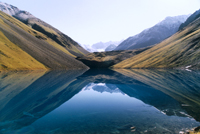 Excluding the Caucasus, the Zailisky Alatau (“multicolored mountains” in Kazakh), one of the foreranges of the Northern Tien Shan (“the celestial mountains”), was the most significant centre of mass-scale mountaineering in the former Soviet Union.
Relief
The Zailisky Alatau is part of the northern ridge group of the Celestial Mountains . Its peaks, covered with snow and ice, reach up as a high ragged wall to the south of the sun-scorched Ili Valley . The Chu River serves as the western border of the ridge, the Charyn River being its eastern edge. The Kungei Alatau Ridge, parallel to the Zailiiski Alatau, lies in the south behind deep lateral valleys of the Chon-Kemin and Chilik rivers. In the middle, both ranges are bridged together to form the Chilik-Kemin knot.
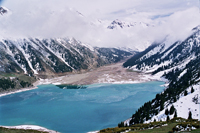 The length of the Zailisky Alatau range is over 400 km , the width varies from 40 to 60 km . The range is arch-shaped towards the south and elongated in the latitudinal direction.
The versatile nature and coloring of these mountains are striking. That is why local residents nicknamed them “Alatau”, or “multicolored mountains”. The length of the Zailisky Alatau range is over 400 km , the width varies from 40 to 60 km . The range is arch-shaped towards the south and elongated in the latitudinal direction.
The versatile nature and coloring of these mountains are striking. That is why local residents nicknamed them “Alatau”, or “multicolored mountains”.
The name Zailisky appeared later in the 19th century, when first Russian military units, marching from the north-east, saw the mountains across the Ili River , looming as a marvelous oasis amongst the steppes.
The central and highest part of the range, the Zailiiski Alatau per se, is sandwiched between the Kastekskiy Pass ( 2,825 m ) in the west and the Amanzhol Pass ( 3,510 m ) in the east, and is about 170 km long. Here, right on the Almaty meridian, the Zailiiski Alatau is bridged with the parallel Kungei Alatau Range to the south. Between them, in deep structural valleys, glacial rivers flow – Chon-Kemin to the west and Chilik to the east of the bridge.
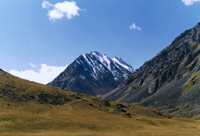 There are 370 glaciers in the central part of the Zailisky Alatau, with a total area of 540 sq. m . In this the central part, the height of the range exceeds 3,200 m anywhere, and it reaches its maximum ( 5,017 m ) in the Talgar Massif, in the Sredniy Talgar River head. There are 370 glaciers in the central part of the Zailisky Alatau, with a total area of 540 sq. m . In this the central part, the height of the range exceeds 3,200 m anywhere, and it reaches its maximum ( 5,017 m ) in the Talgar Massif, in the Sredniy Talgar River head.
The powerful Maloalmatinsky Branch forks out to the north from the main Zailisky Alatau Range , near the city. A few kilometers away, it further splits into two braches – the eastern and the western. Between them, the Malaya Almatinka River flows in the woodlands. The high eastern branch, more than 30 km long, is capped with a series of beautiful peaks: Ordzhonikidze ( 4,440 m ), Mayakovskogo ( 4,200 m ), Manshuk Mametovoi ( 4,100 m ), Abaya ( 4,080 m ), etc. To the north of the Talgar Pass ( 3,200 m ), the Maloalmatinsky Branch declines sharply, loses its glaciation and forks out into a few edges, covered with a bristle of Tien Shan fur trees. This branch serves as a basin divide of the Malaya Almatinka River and the Levyi Talgar River.
The other, western, part of the Maloalmatinsky Branch is known as the Kumbel Range, which means “the sandy pass”. It separates the Malaya Almatinka River from the Bolshaya Almatinka River. A few fan-shaped side edges, known as the Term-Butak, branch off the Kumbel Peak ( 3,200 m ).
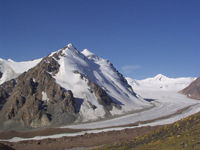 Glaciers GlaciersSnowfields and their glaciers are available only in the highest central part of the Zailisky Alatau, stretched for 120 km from the west to the east. The Zailiiski Alatau has more than 190 glaciers, with a total glaciation area of about 400 sq. km.
On the northern slopes, the glaciers are in the heads of the rivers Uzun-Kargala, Chimalgan, Kaskelen, Aksai, Bolshaya Almatinka, Malaya Almatinka, Talgar, Issyk, and Turgen.
The maximum glaciation is on top of the range in the heads of the Talgar River , where ice and snow cover at least 150 sq. km. There are valley and kettle-hole glaciers here - Dmitriyeva, Konstitutsii, Toguzak, Kalesnika, and Shokalskogo, 4 to 6 km long. Glaciation of the southern slope is less intensive and is mainly concentrated in the heads of the rivers B. Kemin and Chilik, especially to the east of the Chilik-Kemin Bridge . The 12-km-long Korzhnevskogo Glacier, the biggest one in the Zailiiski Alatau, crawls down from the southern slopes of the Talgar Massif. Other big glaciers – Bogatyr and Dzhangyrak – are to the west.
The snow line on the northern slopes is at about 3,700 to 3,900 m , increasing eastward, depending on the direction of slopes. There is hardly any snow cover on the southern side of the range, even at 4,000 to 4,200 m .
Many valleys in their upper part are partitioned with strong ancient and modern terminal moraines which impede access to the upper valleys. For instance, the terminal moraine of Tuyk-Su Glacier is almost 300 m high. The upper valleys of the Bolshaya Almatinka, Talgar, Issyk and other rivers are similar.
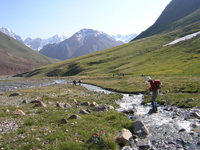 Climate ClimateThe climate in Kazakhstan is dry and strongly continental as the country is far away from oceans and open to cold north and north-east winds. However, the climate of the Zailiiski Alatau sharply differs (for the better) from that of the plains at its piedmont.
Precipitation includes heavy rainfall at the foothills, and snow up in the mountains. This solid precipitation feeds numerous glaciers whence most streams and rivers originate to irrigate blooming foothills. At 3,050 m , the coldest air temperature was recorded in January, dropping down to -30°. In the summer, the temperature sometimes goes up to+ 17°.
An important feature for the climate is the number of clear days, with thunderstorms and precipitation. September has most clear days (oftentimes 20), and May has most days with precipitation (as many as 24). Absolute humidity is higher in the summer and less in the winter. In the summer afternoons, clouds oftentimes cover the tops, with precipitation at higher altitudes.
Thunderstorms occur in April through September. Most days with thunderstorms are in June (7 on average, however, there were 15 thunderstorms in 1953), and in July (5 on average).
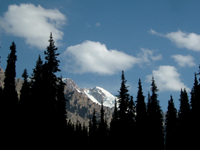 Kaskelenskoye Gorge Kaskelenskoye Gorge
The Kaskelenskoye Gorge is 27 km to the west of Almaty. The Kaskelen River flows along a vast valley and is formed of two sources. The smaller left source originates from a group of glaciers near the Kaskelen Pass ( 3,715 m ). In the upper reaches of the right and main source, flowing alongside the range, the Zailiiski Alatau sharply turns north. There are a number of high peaks here, at the range bend: Kulakbashi ( 3,920 m ), Akkum ( 4,098 m ) and Tur ( 4,350 m ). In 1938, members of the expedition of the Moscow House of Scientists climbed these peaks for the first time.
The side branch which goes off the main ridge has a rock peak, Okzhetpes ( 4,100 m ).
It takes one or two days to get to the upper reaches of the Kaskelen Valley from Almaty. The paths in the gorge are pretty good, and rivers have bridges. You can get to the Chon-Kemin River valley (at the foothills of the Kungei Alatau Range , in front of the majestic Chotkala Group) from the upper gorge via Kaskelen and Dzhaya passes, or to Lake Issyk-Kul via the Dyure Pass ( 3,733 m ).
The next big valley to the east of the Kaskelen River is the Aksai River Gorge. There are more than 15 small glaciers in its upper course (Shnitnikova Glacier being the biggest, not more than 3 km ).
Between the Aksai and Bolshaya Almatinka valleys, the Zailiiski Alatau has an offset to the north, and the deep wooded valley of the Kargalinka River wedges into its top. The snow-covered crest of the dividing ridge in the upper course is crowned with three snow-capped peaks, whence the Kargalinskiy Glacier crawls down.
Good paths go up to the valley. The highest tops are mainly in the upper course of the Levyi Aksai, reaching 4,500 meters . A small Kargalinka gorge lies behind the Aksai Valley and is of no interest for mountain climbers.
The Bolshaya Almatinka River flows in western outskirts of Almaty and originates from two sources separated with a branch which has a majestic pyramid of the Bolshoi Almatinskiy Peak at the edge. The Prokhodnaya River goes to the west of this branch, and the Ozyornaya River flows to the east. They merge in the piedmont to form the Bolshaya Almatinka.
The Prokhodnoye Gorge is about 19 km long. The Prokhodnoi Pass ( 3,609 m ) is in its upper part just slightly covered with snow. It is the shortest and most convenient way from Almaty to the upper reaches of the Chon-Kemin River . For the first 25 km from the city to Alma-Arasan Rest House, the highway goes along the Bolshaya Almatinka Valley , and after it branches off, along the Prokhodnaya River valley. Then, a difficult road goes along the valley which allows to go up the Prokhodnoi Pass. Then, you begin to descend southward along the Almaty River until it merges into the Chon-Kemin River ( 13 km ).
There are no significant peaks near the Prokhodnaya River . About a dozen of glaciers are not longer than 1- 1.5 km . This area is first of all interesting for mountain tourists.
Ozernoye Gorge
The Ozyornaya River has two sources fed by glaciers going down from the northern slopes of the Zailiiski Alatau Range and its side branches.
The main ridge in the upper part of this area is about 20 km long, with an average height of 4,100 m . There are a number of peaks of up to 4,500 m above its crest in places where side ridges branch off, including the Legostayeva Peak ( 4,468 m ) in the head of the Chernogo Glacier.
The Sovetov Peak ( 4,100 m ) is widely known as it is a beautiful and easy peak in one of the side ridges of the Maloalmatinskiy Branch.
The Ozyornaya River basin has more than 20 glaciers, the biggest one being the Gorodetskogo Glacier (about 5 km ).
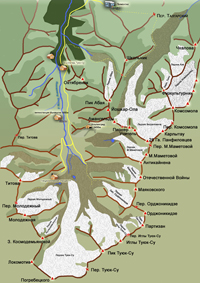 Touyuk-Su Area Touyuk-Su AreaThere are 12 glaciers in the upper reaches of the Malaya Almatinka RIver . The central 4-km-long glacier is of the valley type and called Tuyuk-Su (“locked water”). The main glacier is surrounded by fan-shaped smaller ones located only on the northern slopes. In the past, they were connected to the main one and formed a complex valley glacier.
A big and picturesque valley of the Issyk River is in the eastern part of the Zailiiski Alatau Range . The western border goes along the Talgar Branch. In the upper reaches of the Issyk River , the Zailiiski Alatau Range curves to the south to form a vast cirque separated into three big chambers occupied with glacier groups (eastward): Bos-Kulskaya , Ak -Kulskaya and Kassinskaya. The main range, as well as the Talgar and Issyk Branches, also have a lot of different peaks.
The biggest glaciers in the Issyk River basin , 3 to 4 km long, include: Zharsai, Grigoryeva, Palgova, and Kassina. There are more than twenty smaller glaciers here. The Issyk Valley is rightfully known as one of the most beautiful spots in Kazakhstan .
The Talgar peak 5017m. The highest point of Zailisky Alatau ridge.
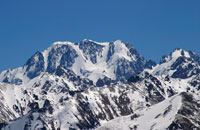 The Talgar River valley lies 25 km to the east of Almaty. It is a big river flowing down from the northern slopes of the Zailiiski Alatau Range , formed by two branches – the Levyi (“left”) Talgar on the west and the Pravyi (“right”) Talgar on the east. Another branch, the Srednyi Talgar, flows in the right source near its merger with the left branch.
The History of Peak of Talgar
Talgar was discovered by scientists back in the mid-19th century, however, the notorious confusion of the region’s orography, with identification of peaks as they are approached from The Talgar River valley lies 25 km to the east of Almaty. It is a big river flowing down from the northern slopes of the Zailiiski Alatau Range , formed by two branches – the Levyi (“left”) Talgar on the west and the Pravyi (“right”) Talgar on the east. Another branch, the Srednyi Talgar, flows in the right source near its merger with the left branch.
The History of Peak of Talgar
Talgar was discovered by scientists back in the mid-19th century, however, the notorious confusion of the region’s orography, with identification of peaks as they are approached from 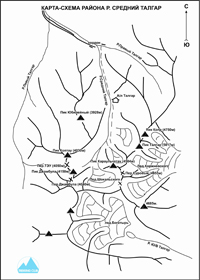 the the 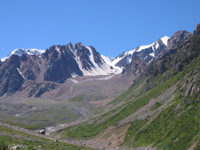 north or from the south, did not allow to succeed in climbing. north or from the south, did not allow to succeed in climbing.
It was not until 1935 that the mountain-climbers’ persistence was awarded. Having climbed the northern side of the massif, a group led by Kh. Rakhimov called the place Kopr. The same year, 12 young mountain-climbers led by V. Zimin conquered the south-western top ( 4,860 m ) in severe winter conditions. Three years after, people from Novosibirsk led by Ye. Alekseyev reached the 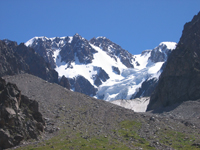 northern peak ( 5,000 m ) in a February cold and snowstorm. And finally, Siberians L. Katukhin, G. Makatrov and I. Kropotov won the highest peak of the “ Multicolored Mountains ”, the head peak of Talgar . It took the mountain-climbers three years to follow the easiest routes. northern peak ( 5,000 m ) in a February cold and snowstorm. And finally, Siberians L. Katukhin, G. Makatrov and I. Kropotov won the highest peak of the “ Multicolored Mountains ”, the head peak of Talgar . It took the mountain-climbers three years to follow the easiest routes.
During World War II, while training mountain sharpshooters, Colonel Gorin made a few ascents, and one of the Zailiiski Alatau peaks was named after him. A tragedy on the south-western slopes of PeakTalgar took his life.
The year 1949 put a period in the chronicles of climbing Talgar. The mountain-climbers from 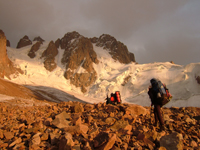 Metallurg Camp led by F. Lemsterm made a traverse going up along the north-western ridge and down to the south-east. Metallurg Camp led by F. Lemsterm made a traverse going up along the north-western ridge and down to the south-east. The history of climbing Talgar was not completed yet. In 1951, A . Alekseyev’s group made a traverse from the south-west to the north, having ascended to the southern top from a sink between the southern and western peaks and descended along the north-eastern ridge.
Conquerors of the first wall of Talgar had thoroughly prepared their route and named a few more of them. However, no serious attempts were made until 1958 to conquer any other wall of Talgar.
In 1958, a team led by Grandmaster I.V. Soloduyev came to Talgar Camp. Soloduyev had a great talent as a violin player of the Bolshoi Theater and as courageous mountain climber. The backbone of the team included young climbers: V. Barzykin, L. Dmitriyev, Yu. Novikov, G. Stepanov, and A. Snesarev. On August 18, 19 58 the group completed the new way on the western wall of the southern peak of Talgar . This route took the 4th place in the U.S.S.R mountain climbing championship and classified as Category 5B.
Every year, the geography of the team trying to win new ways towards Talgar Peak was growing on. In 1962, a group of Latvian climbers took part in the massif climbing. The north-western wall of the south-eastern Talgar was chosen as the point to ascend. The Latvian climbers were storming the wall for five days in severe weather. As a result, a new route was laid out classified as Category 5A. To commemorate the climbers, a nameless peak in the south-eastern branch of Talgar was named Daugava.
In 1968, another Category 5B route was completed, on the same south-western wall of the southern peak of Talgar . The ascending report said: “On the western wall of Southern Talgar, the mountain climbers could not but pay attention to menacing cliffs rising up towards the peak of Southern Talgar, to the right of the route followed by Snesarev’s group. The will to climb those walls appeared back in 1966, during the climbing of “Snesarev’s Wall”. This will was finalized when we were climbing the north-western wall of the south-eastern Talgar while traversing the Talgar Massif. The three days of observing the wall and great pictures of the route confirmed that difficult route could be climbed, both technically and tactically”. The group was led by Grandmaster M. Akimenkov and included 3 first-class climbers: Ye. Belovolov, V. Denisov and Yu. Popenko.
In 1978, Talgar Camp was destroyed by a mudslide which hampered development of this region. It was then only used as a base for stationary groups of climbers to make classification ascends.
In 1991, the region was shut down for visits due to stricter rules of visiting Almaty Reserve as the massif was within its area. It wasn’t until 2000 when the region was open again for visits by tourists and mountain climbers.
|
 |
|
 |
 |
|
|
|
|
 |
|
